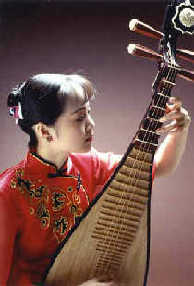
The earliest form ofpipaknown appeared in the Qin Dynasty (221-207BC). It had a long neck, leather surface and circular sound box, and was held upright. Around the time the Qin was succeeded by the Han Dynasty, this instrument underwent a number of modifications and it evolved into theruan,qinqin, three-string,yueqin, etc. All these forms of thepipahad the common characteristics of a straight neck and circular sound box. The crooked neck was in fashion from the time of the Wei Dynasty to that of the Tang Dynasty. Similar instruments, such as the guizipipa, five-string and hulei were all-semi-pear-shaped, and were all referred to as "huqin".
From the Tang and Song dynasties, thepipaunderwent unceasing development, until it attained the form it has today: a semi-pear-shaped sound box, paulownia-wood top board, the neck curved backwards, "xiang" and "pin" frets on the body and neck, four strings and four- or five-octave intervals. Two major changes which took place in the course of thepipa's evolution were the practice of holding the instrument upright instead of horizontally while playing it, and the use of five fingers to pluck the strings, instead of using a plectrum. In the 20th century, through the unremitting efforts of a large number of performing artists and composers, a plethora of techniques and compositions has emerged, with the result that thepipais now one of China's most important national instruments for solo, accompaniment and ensemble recital. Leading modernpipaartists are Li Tingsong, Wei Zhongyue, Liu Dehai and Lin Shicheng.
The long-time history endowedpipaa rich collection of scores and a mature performing technique. Some of the most noteworthypipaworks are:
Surrounded on All Sides, also known asThe State of Han Conquers the State of Chu. The score first appeared in a collection ofPipa Scores of 1819.The Sunny Hall Collection of the Ming Dynastycontains a graphic account of the pipa master Yang Yingceng performing this piece, which belongs to the genre known as "martial suites". Its background is the struggle between Liu Bang, king of the State of Han, and Xiang Yu, king of the State of Chu, and specifically the final battle between them at Gaixia in 202. The work lauds the victor, Liu Bang.Surrounded on All Sidesgives full play to all the pipa techniques - rubbing, plucking, pushing, sweeping, etc., and the music is imbued with the stirring flavor of battle and heroism. Its narrative structure is divided into three parts: (1) Battle preparations, which is again divided into setting up camp, striking up the band, mustering the officers, forming ranks and marching off; (2) The battlefield, which is again divided into the ambush, the engagement at Cockcrow Hill and the battle of Mount Jiuli; and (3 the conclusion, which is divided into the defeat of Xiang Yu's army, suicide by the River Wu, the victory celebrations, the exploits of the generals, and the returning to camp in triumph.
The Overlord Doffs His Armoralso describes the battle of Gaixia, but whileSurrounded on All Sidesis a paean of praise to the victorious Liu Bang,The Overlord Doffs His Armorstresses the agony of the defeat suffered by Xiang Yu, king of Western Chu. Hence, the popular saying: The successful playSurrounded on All Sides, while the unsuccessful playThe Overlord Doffs His Armor. With the message that heroism cannot be judged on the basis of success or failure, the latter piece of music uses mournful measures to portray the distress of Xiang Yu, the greatest hero of his time. These two complementary works are representative of the "martial suite" pipa genre.
The score ofThe Sunny Spring Classic, orSunny Spring Snow, first appeared in theNew Scores of 13 Daqu Pipa Suites of the Northern and Southern Schools, in 1895, edited by Li Fangyuan of the Qing Dynasty. It belongs to the "literary suite" genre. Its composition is succinct and its mood is sprightly, and its contains variations within an overall unity. It conveys the romantic and uplifting feeling of spring scenery.
The score ofFlutes and Drums at Sunset, first appeared in a manuscript by Wu Wanqing in 1875. It is included in theNew Scores of 13 Daqu Pipa Suites of the Northern and Southern Schools. The structure includes a lengthy 10 parts. It is an elegant and charmingly lyrical piece of music. The first section is an introduction, which describes boats bobbing on the river at sunset while flutes and drums play in harmony. The gentle plucking of the pipa's strings is made to sound like the tapping of drums, while twanging them gives the impression of undulating flute notes. The whole presents an enchanting picture of a tranquil autumn evening by a river with boats, and the moon starting to rise.











